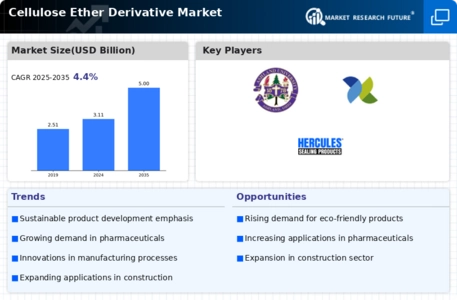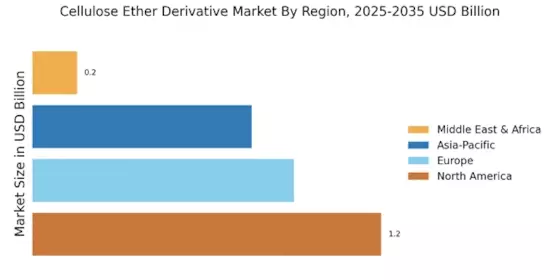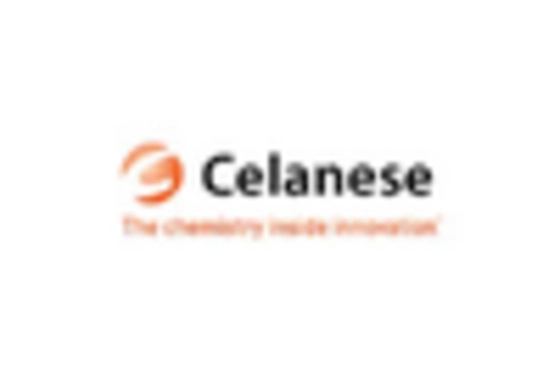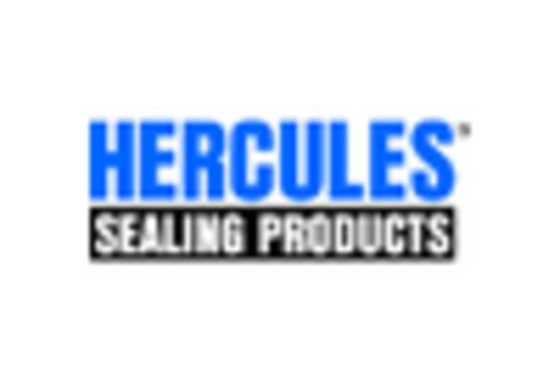Rising Demand in Construction Sector
The cellulose ether derivative market is experiencing a notable surge in demand, particularly from the construction sector. Cellulose ethers, such as hydroxypropyl methylcellulose (HPMC), are extensively utilized in cement-based products, enhancing workability and water retention. The construction industry's growth, driven by urbanization and infrastructure development, is projected to reach a value of approximately 10 trillion USD by 2025. This expansion is likely to bolster the cellulose ether derivative market, as these materials are essential for producing high-performance building materials. Furthermore, the increasing focus on energy-efficient and sustainable construction practices may further elevate the demand for cellulose ethers, as they contribute to improved thermal insulation and reduced environmental impact.
Expanding Pharmaceutical Applications
The cellulose ether derivative market is witnessing a significant expansion in its applications within the pharmaceutical sector. Cellulose ethers are widely employed as excipients in drug formulations, enhancing solubility and bioavailability. The pharmaceutical market is anticipated to grow at a compound annual growth rate (CAGR) of around 5.5% through 2025, driven by the rising prevalence of chronic diseases and the demand for innovative drug delivery systems. This growth is likely to create substantial opportunities for cellulose ether derivatives, as they play a crucial role in formulating various dosage forms, including tablets, gels, and suspensions. The increasing emphasis on patient-centric formulations may further propel the cellulose ether derivative market, as these materials offer versatility and functionality in pharmaceutical applications.
Technological Innovations in Production
The cellulose ether derivative market is poised for growth due to ongoing technological innovations in production processes. Advances in manufacturing techniques, such as the development of more efficient synthesis methods and improved quality control measures, are enhancing the production capabilities of cellulose ethers. These innovations are likely to reduce production costs and improve product consistency, making cellulose ether derivatives more accessible to various industries. Furthermore, the integration of automation and digital technologies in manufacturing processes may streamline operations, leading to increased output and reduced lead times. As a result, the cellulose ether derivative market is expected to benefit from enhanced supply chain efficiencies, ultimately supporting the growing demand from diverse applications.
Consumer Preference for Natural Ingredients
The cellulose ether derivative market is benefiting from a growing consumer preference for natural and organic ingredients across various sectors, including food and personal care. As consumers become more health-conscious, there is a marked shift towards products that are perceived as safe and environmentally friendly. This trend is reflected in the food industry, where cellulose ethers are utilized as thickening agents and stabilizers in a range of products. The global market for natural food additives is projected to reach approximately 25 billion USD by 2025, indicating a robust demand for cellulose ether derivatives. Additionally, in personal care products, cellulose ethers are valued for their emulsifying and film-forming properties, further driving their adoption in formulations that cater to the growing demand for natural cosmetics.
Regulatory Support for Sustainable Practices
The cellulose ether derivative market is likely to gain momentum from increasing regulatory support for sustainable practices across multiple sectors. Governments and regulatory bodies are implementing stringent guidelines aimed at promoting environmentally friendly materials and reducing carbon footprints. This regulatory landscape is encouraging manufacturers to adopt cellulose ether derivatives, which are derived from renewable resources and are biodegradable. The market for sustainable materials is projected to grow significantly, with cellulose ethers positioned as a viable alternative to synthetic polymers. As industries strive to comply with these regulations, the cellulose ether derivative market is expected to expand, driven by the demand for sustainable solutions in packaging, construction, and consumer products.


















Leave a Comment